E-Commerce | Auto-Updating Copy | Automated Texts + Product Descriptions
FAQs For Your Online-Shop: What Advantages They Offer And How You Find Customer Relevant Questions And Answers
Reading Time 10 mins | September 12, 2022 | Written by: Anne Geyer

FAQs – written out as Frequently Asked Questions, are an important part of the user experience. Ideally, they answer your visitors’ most important questions and are a great opportunity to improve your customer service and user experience.
Contentwise, FAQs can be used to accompany the whole customer journey. For example, they cover questions about single products as well as general conditions like payment or shipping options.
In addition FAQs are good for search engine optimization if they contain the right keywords. Suitable (internal) links, a good formatting and readability of your content help as well to provide a good customer experience which has positive effects on the complete online store.
What does a FAQ look like?
FAQs take relevant questions about terms or issues specifically. The questions are followed by a precise definition or explanation as answer.
The goal of FAQs is to answer the chosen questions in a nutshell, yet completely and satisfactorily for the reader. If the answer becomes too long, we recommend to split it into two individual questions with shorter answers. Use relevant keywords at the beginning of the answer if possible.
FAQs have to be phrased in simple terms that everyone can understand. Don’t use complicated sentence structures or specialist terms (or at least explain them). As an addition, you might provide a link with further information. The structure of a FAQ looks like this, for example:
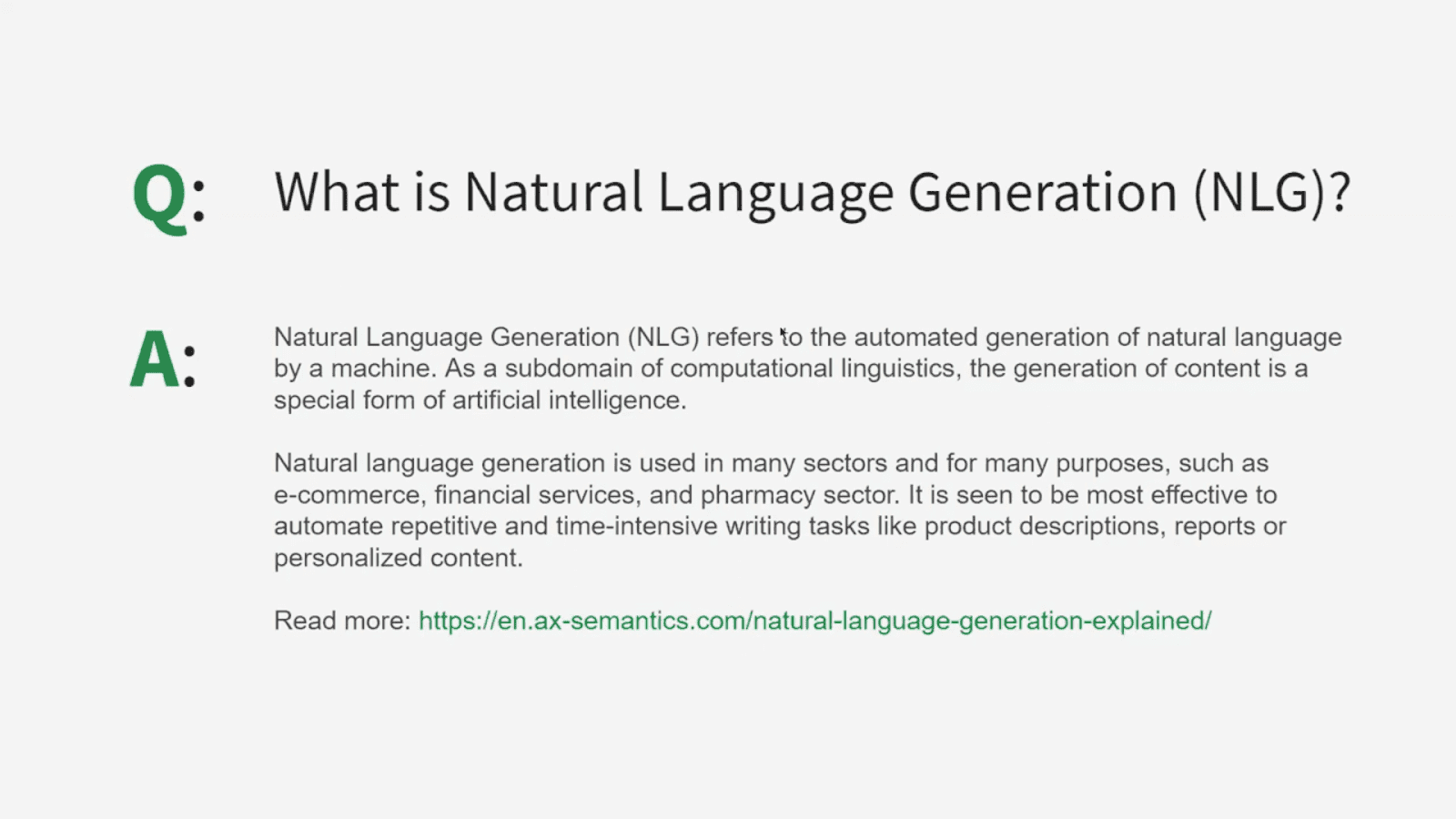
Why are FAQs so beneficial for online shops?
FAQs are an enrichment for your online store in three ways:
- SEO-relevant content increases the visibility of your website in search engines. If important questions and answers about a product are listed on your product page, this increases the relevance of your website. Search engines categorize FAQ pages also as relevant content. For these FAQ pages exists a FAQ scheme that describes the perfect structure of such pages. If that’s maintained well, Google will include single questions into their Featured Snippets. That’s the box on the top of the SERPs, titled with “People also asked” – a very prominent place that immediately catches the eye of users.
- Reduce the workload of your customer service department, as important customer questions are answered in the FAQs. This saves employees a lot of time because they no longer have to deal with so many inquiries. In addition, many stores have seen a drop in return rates because the FAQs eliminate uncertainties or even misunderstandings among customers before they place an order.
- The increased transparency of product information and purchasing processes with the help of FAQs strengthens the customers trust in your store. This also contributes to customer acquisition.
Two types of FAQs for online shops
Two types of FAQs can be defined for online stores: Product FAQs, which are located on the product detail pages, and store FAQs, which answer general questions about the store and are located on a separate FAQ page.
Product-FAQs: It is optimal to create FAQs for each individual product in your online store. The questions and answers are based on the respective product data. These FAQs are located exclusively on the product detail page and deal e. g. with questions about available colors, materials used, certificates, cleaning instructions etc. Since this is very time-consuming, the use of a text automation software is advisable.
Shop-FAQs: There are also FAQs that answer general questions about your store, for example, shipping and payment options, return policies, etc. These questions and answers are available on a special FAQ page.
You can also use store FAQs as content underpinning for your product detail pages, for example, to fill up the content on individual pages and thus enhance the individual product page. However, it is not enough to simply copy the FAQs! It is important to create different variations of the questions and answers for the individual product pages to prevent duplicate content. Manually this is a big effort, which is why the use of an automation software, such as the one from AX Semantics, is worthwhile.
We do know now that FAQs are essential for online shops and how beneficial they are – for customers and store operators. So how to find the right questions and answers for your product pages and your shop-FAQs? There are three ways to find customer-oriented concerns and problems:
1. Perform a keyword analysis
Find out what keywords users are searching for in relation to your products and build your questions and answers from them. If these FAQs are well keyworded, i.e. they match the SEO rules, they will improve the ranking of your web pages in the search engines.
Example question: “How do I get a discount in the online shop of company X?”
2. Ask your customer support team
Your customer support team knows best what questions customers have regarding products and services. Don’t forget to ask your support team, which questions are asked most frequently. If you address these questions in FAQs in your online store, it will save your team a lot of time by reducing customer inquiries.
Example question: “How to return product X?”
3. Complete the product description with questions about features
What do you want your customer to know about your product? If you want your customers to know specific informations about your products, a product description in question-answer format is also suitable for this. Depending on the product, you can also include SEO-relevant questions.
Example question: “What is the advantage of Material X in this product?”
The most qualified answers to your questions will be provided by specialists who are familiar with your product and have knowledge of specific product information. You can also gain detailed information from product data. In your answers, avoid empty phrases and generic statements that are unspecific or inaccurate. Short and to the point answers contribute to a good user experience.
Generate FAQs for your online store in only 3 steps with AX Semantics
FAQs concerning the store in general still require relatively little effort. The situation is different for FAQs on individual products, the creation and updating of which require an enormous consumption of resources. Especially for product descriptions it’s important that the customer gets answers to all current questions directly on the product detail page, without being redirected to a separate FAQ page or having to call it up himself. Automating FAQs makes sense and offers the advantage that you can generate FAQs tailored to the product and the situation of the customer journey. In the following, we explain how you can automate FAQs for your store.
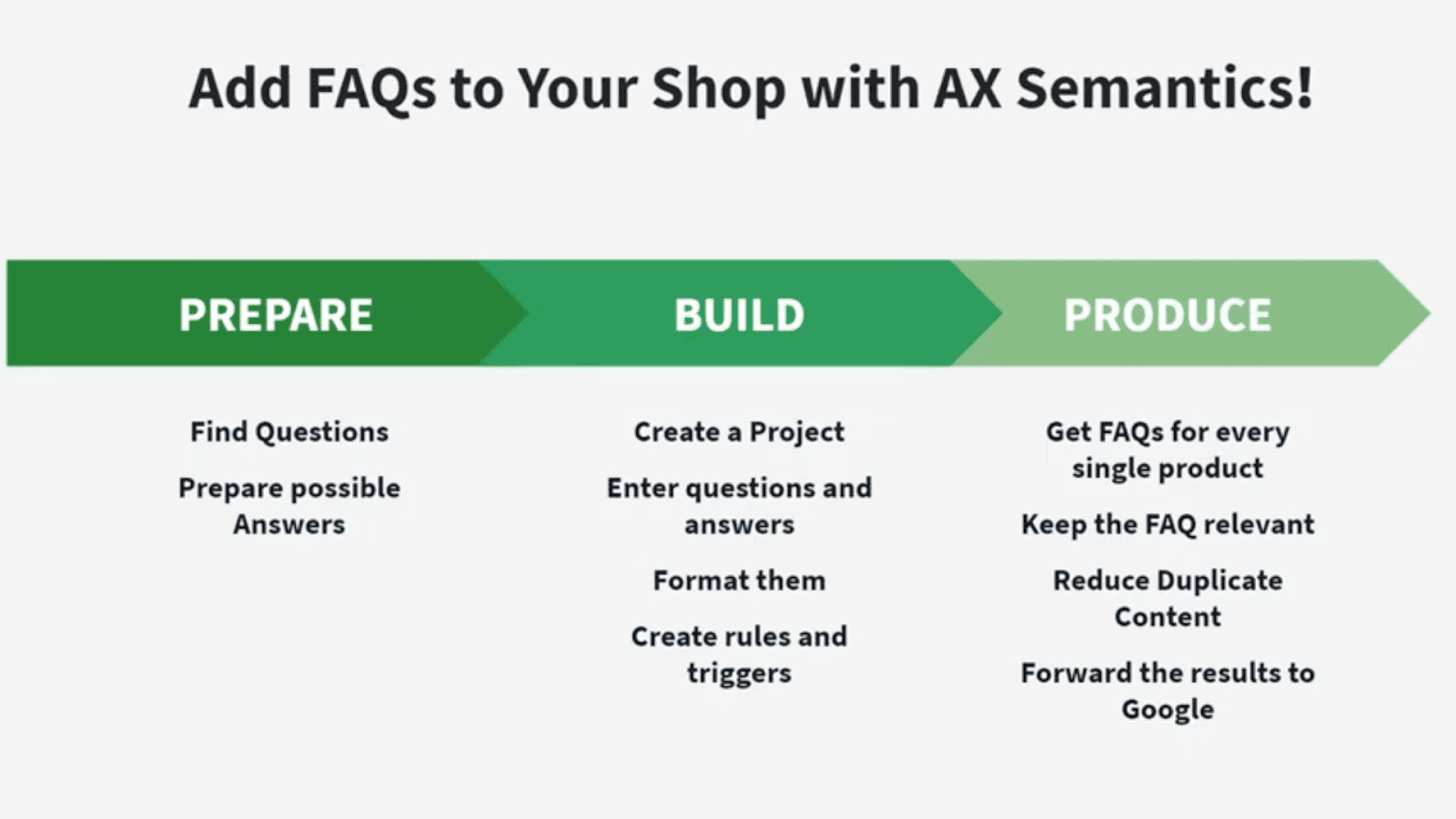
Your FAQ project in the AX Semantics software
Let's say you've found the questions and answers relevant to your online store and products, and now you want to create FAQs for your product pages.
To save time and money, and to optimize your processes, to use an automation software is your go-to. If you automate your FAQs for product pages, you have the option to automatically generate FAQs tailored to the product from your data sets. With AX Semantics you can easily create variance in your texts. But what does this look like in concrete terms?
- Containers help to formulate precise questions: "Is it possible to change batteries of a Samsung Galaxy S20 FE?" instead of "Is it possible to change the batteries of cell phones?" Without text automation you need to write individual FAQs for every single product and each category.
- With the help of data analysis, you can find the suitable answers for each product. For example, you can differentiate questions about shipping costs for light goods or heavy goods.
- Triggers and branches are used to precisely control the selection of questions and answers as well as their sequence.
The following video shows questions about a smartphone with the corresponding answer variants, each of which is played out automatically:
FAQs for online shops - Example 1: How Roboexpert has upgraded its product pages with automated FAQs
Roboexpert (now rebranded as tink) is an online store for household and garden robots, gardening tools and e-bikes. The company successfully automates texts including product descriptions with FAQs with AX Semantics' software.
The text automation allows roboexpert to enrich and optimize the automatically generated product descriptions by answering frequently asked questions. The FAQs of roboexpert are a compilation of the most frequently asked customer questions and contain the corresponding answers individually for each product.
In terms of content, the FAQ section answers for example questions about the advantages of the product. In addition, the company also answers its customers' general questions about delivery time or shipping costs.
Thanks to the automatic generation of frequently asked questions and their answers by the AX Semantics software, roboexpert saves a lot of time and money. As the software creates SEO-optimized FAQs, the automation additionally leads to an increased visibility of the products.
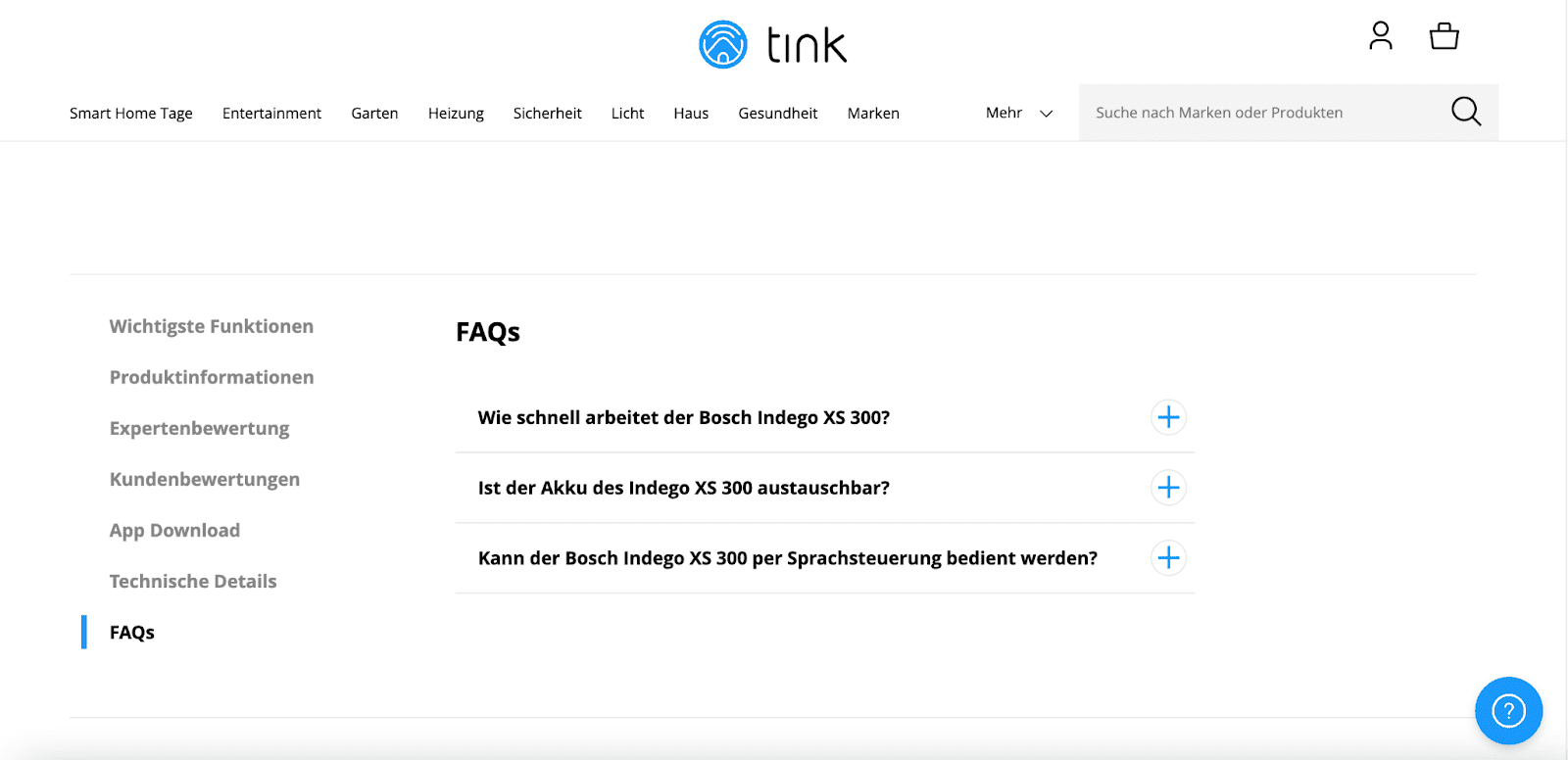
FAQs for online shops – Example 2: How Webgears reduced duplicate content using text automation
Webgears is an international e-commerce service that operates leading smart shopping portals. The company automated coupon descriptions with AX Semantics' software and thereby drastically reduced duplicate content. Before they started using the AX content automation software, the similarity between FAQs on different topics was up to 59 percent as the following example on coupon descriptions shows:
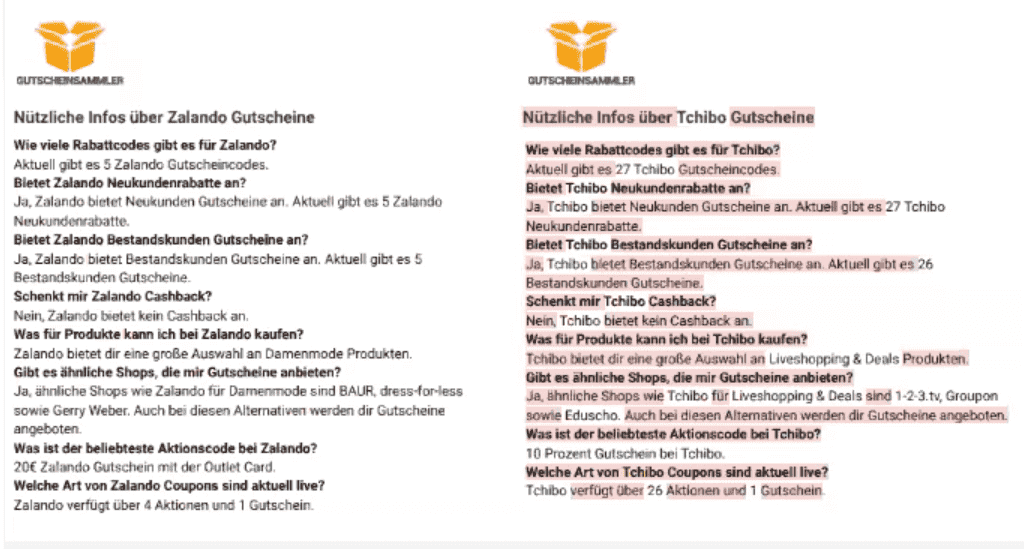
Using variance methods in AX Semantics' software, Webgears massively improved website content, reducing the similarity between descriptions to between 14 to 24 percent.
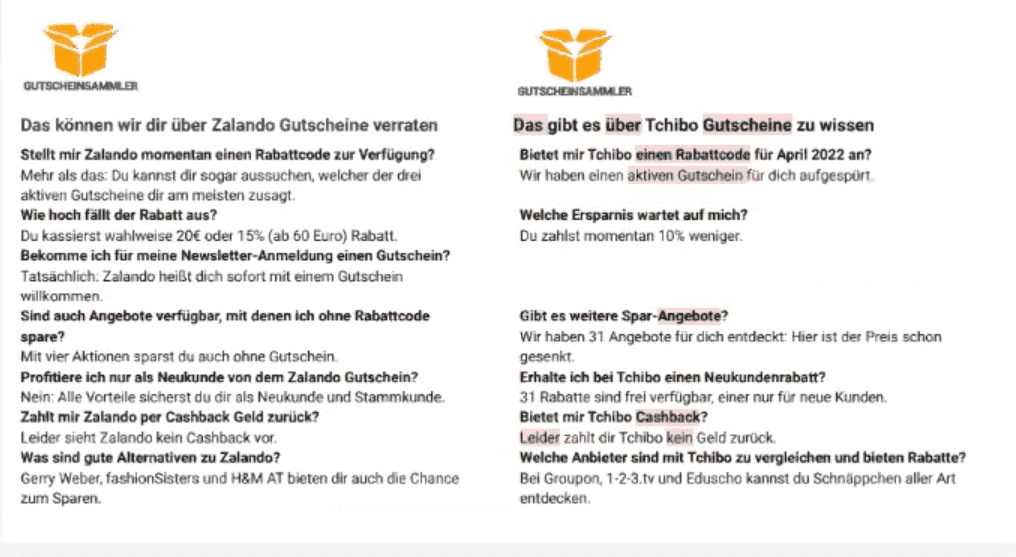
Conclusion
We've now talked about how to find the best questions for your e-commerce business and the importance of making sure that when you formulate statements, the questions are tailored to the product at hand and the answers accurately address the issues raised.
With AX Semantics' natural language generation software it is possible to create FAQs for each product in a resource-saving way and to place them on the individual product detail pages. This helps to create a good user experience and has a positive effect on customer loyalty. The software automatically plays out the right FAQs for each product. Since the software is based on entered data, the statements are precise and perfectly matched to the product.
It makes sense to use automated FAQs when dealing with a large number of products, some of which also differ only in degree. Manual implementation costs a lot of time and money and is likely to lead to errors. With content automation, you get the necessary variance in your questions and answers, easily avoid duplicate content, reduce the workload of your team and ensure a better user experience and search engine optimization of your pages.
